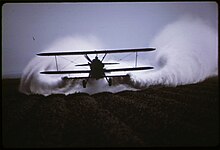
Back رش جوي للمبيدات Arabic Letecké práškování Czech Agrarflug German Ψεκασμός από αέρος Greek Aplicación aérea de plaguicidas Spanish کاربرد هوایی Persian Épandage aérien French ריסוס אווירי HE Agrolotnictwo Polish 农业航空 Chinese




Aerial application, or what is informally referred to as crop dusting,[1] involves spraying crops with crop protection products from an agricultural aircraft. Planting certain types of seed are also included in aerial application. The specific spreading of fertilizer is also known as aerial topdressing in some countries. Many countries have severely limited aerial application of pesticides and other products because of environmental and public health hazards like spray drift; most notably, the European Union banned it outright with a few highly restricted exceptions in 2009,[2] effectively ending the practice in all member states.
Agricultural aircraft are highly specialized, purpose-built aircraft. Today's agricultural aircraft are often powered by turbine engines of up to 1,500 shp (1,100 kW) and can carry as much as 800 US gallons (3,000 L) of crop protection product. Helicopters are sometimes used, and some aircraft serve double duty as water bombers in areas prone to wildfires. These aircraft are referred to as SEAT, or "single engine air tankers."
- ^ "Delta Air Lines | DL | DAL | Heathrow". Heathrow Airport. Retrieved 2022-05-06.
- ^ Cite error: The named reference
sprayBanEurowas invoked but never defined (see the help page).
© MMXXIII Rich X Search. We shall prevail. All rights reserved. Rich X Search